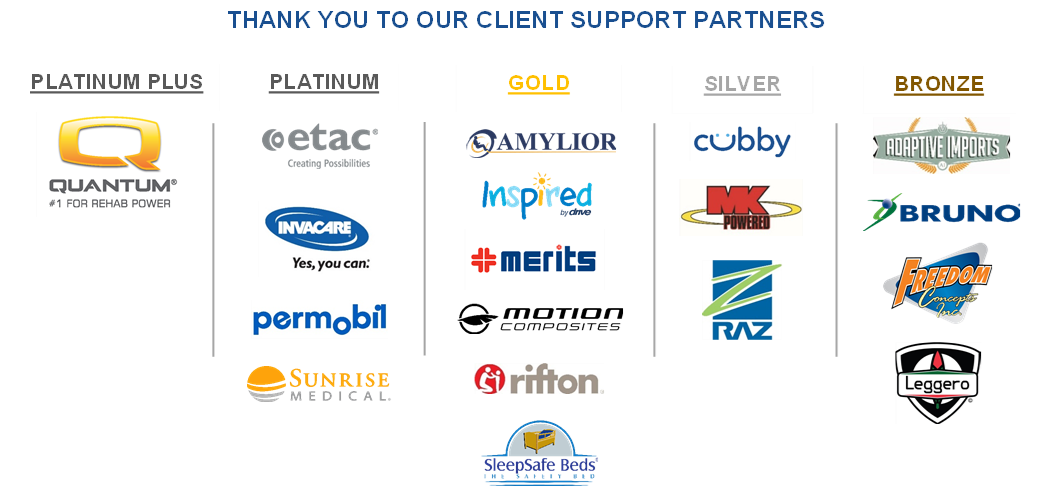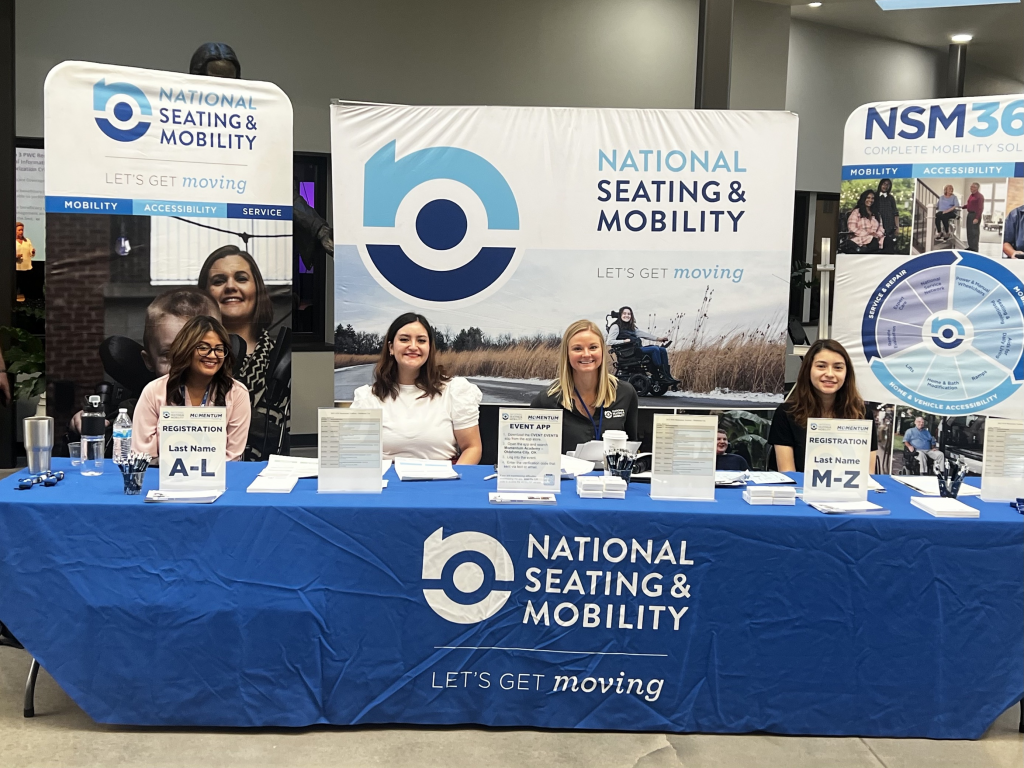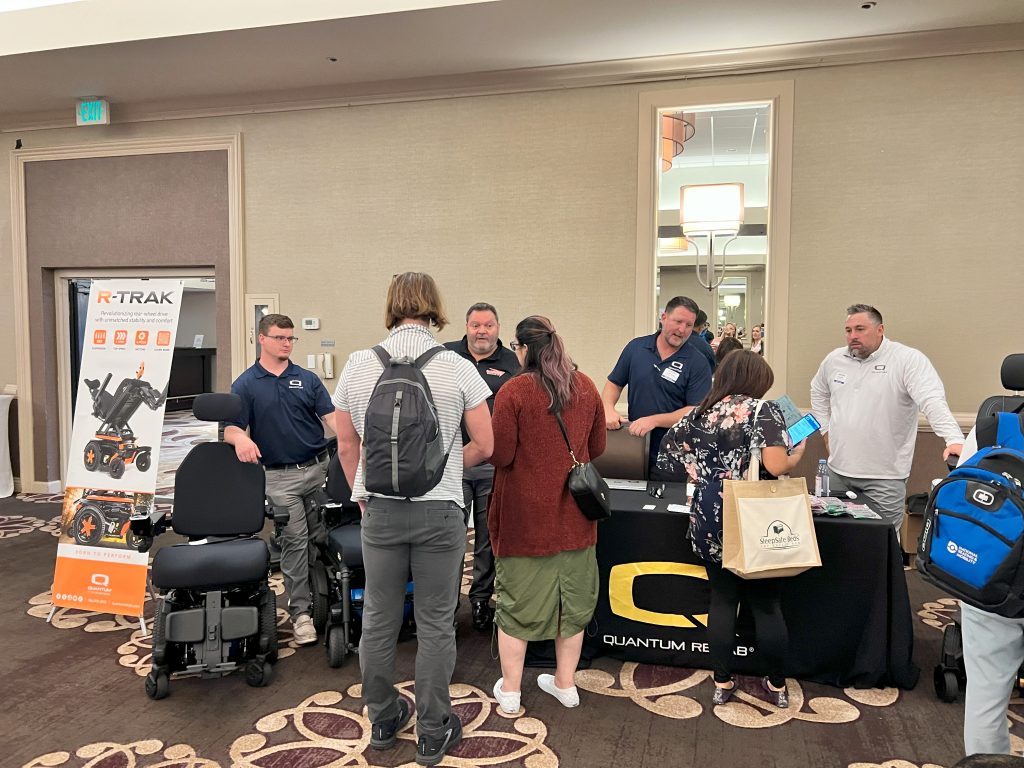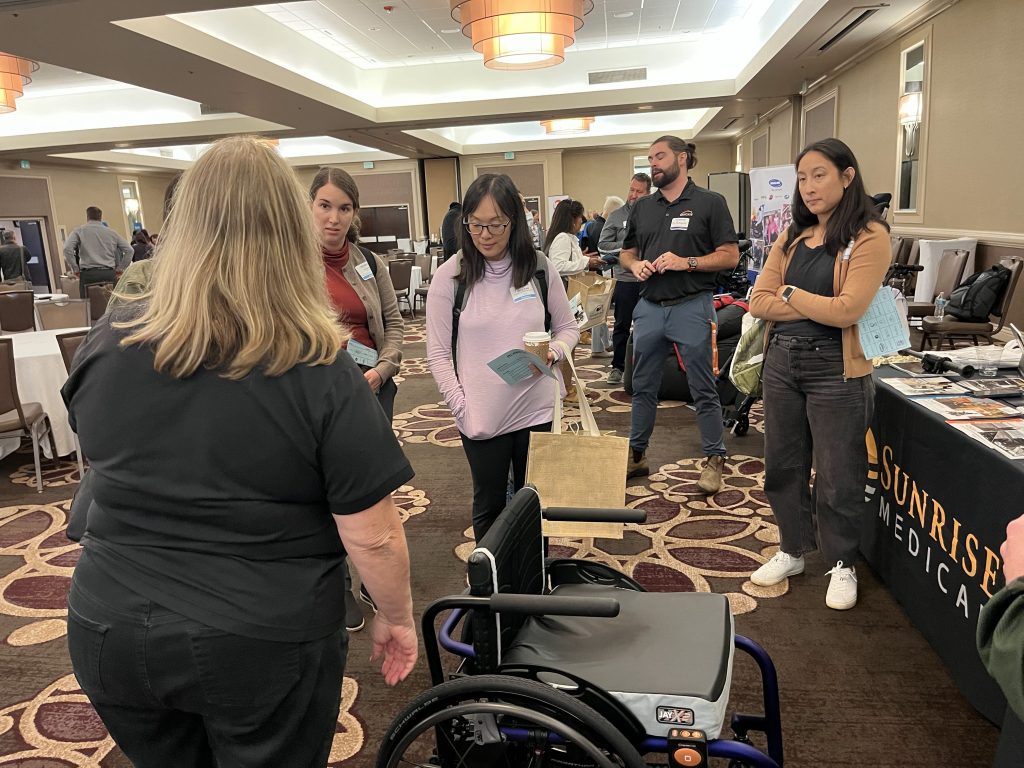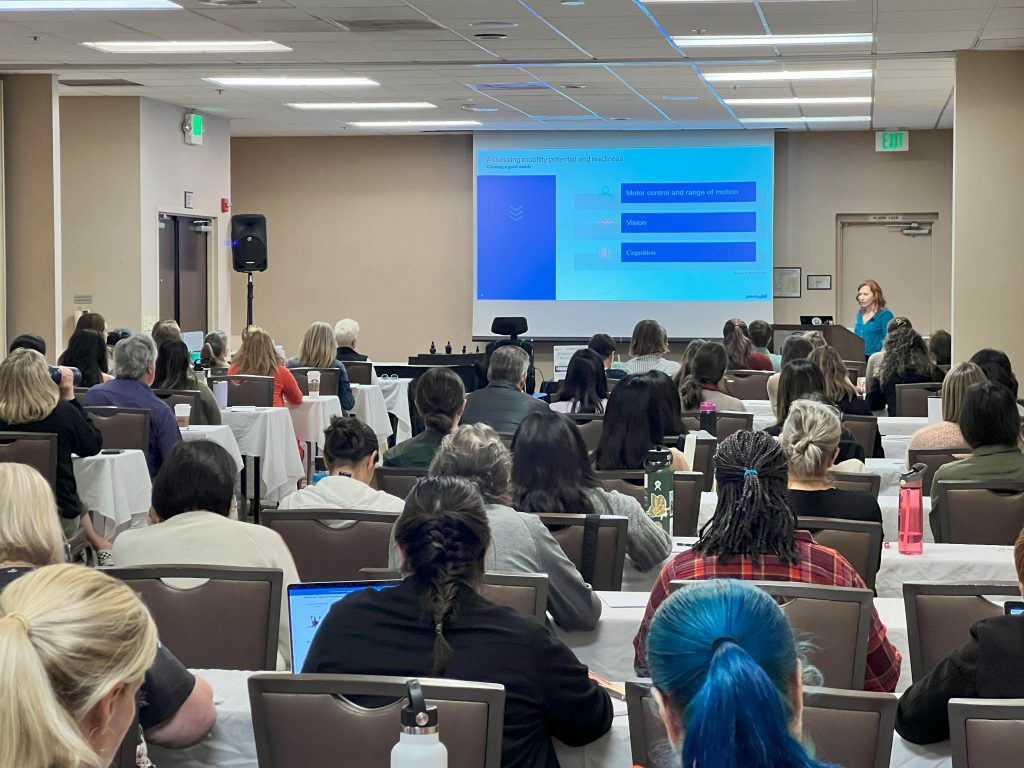OKLAHOMA CITY MOMENTUM ACADEMY EDUCATION & TECHNOLOGY EXPO
Friday, October 24, 2025
Church of the Servant
Oklahoma City, OK
Event Highlights
- Earn up to 6 hours of continuing education (CE) credits for PT, PTA, OT, COTA, ATP
- Network with industry professionals
- Exhibit hall with the latest assistive technology
- Breakfast and lunch provided
The rate is: $69 for up to 6 CE credits
Hotel Recommendations
Home2 Suites Quail Springs
(1.1mi), 5500 NW 135th St, rate $120
Homewood Suites Quail Springs
(0.9mi), 6000 W Memorial Rd, rate $149
Residence Inn Quail Springs
(2.0mi), 13900 McAuley Blvd, rate $166
SCHEDULE OF EVENTS
7:00am - 7:45am: Registration
7:45am - 8:00am: Kick-off
8:00am - 12:00pm: Education Courses
12:00pm - 1:00pm: Lunch
1:00pm - 5:00pm: Education Courses
The Supplier Exhibit Hall will be open throughout
the day with 2 hours of dedicated exhibit hall time.
Click here for full event schedule.
CONTINUING EDUCATION COURSES
Evidence-Driven MWC Configuration: Optimizing Fit and Function for Different Body Types and Propulsion Methods
0.1 CEU / Intermediate
Presented by: Heather Cianciolo, OTR/L, ATP/SMS
Permobil
This 1-hour course is designed to help providers and clinicians develop best practices for recommending complex rehab technology (CRT) manual wheelchairs for individuals with varying body proportions and propulsion styles. Using the ICF model, the course will guide participants through the decision-making process, balancing evidence with functional outcomes to ensure successful CRT seating and wheeled mobility solutions. Through case examples and clinical reasoning discussions, participants will learn to identify clients' individual clinical and functional goals, driving configuration and component recommendations that enhance functional mobility outcomes, participation, and overall satisfaction with the equipment, ensuring a good person-technology match.
Custom-Configured Seating - Designing Seating & Mobility for Growing Bodies
0.1 CEUs / Intermediate
Presented by: TBD
Etac/Ki Mobility
Custom-configured seating may be perceived by some as a challenging puzzle. With all the possible configurations and myriad shapes, components, and materials to select from or define, how does one determine what to do? Understanding the clinical decision-making as well as the purposes and capabilities of this seating technology can profoundly influence successful outcomes. It can be a challenge to get it right, but it is called complex rehab, after all.
In this presentation, we will briefly review the relevant components of a postural assessment. We will then discuss how to translate the findings from that assessment to specify and design the custom-configured seating system and accurately work our way through and complete the order form. Considerations will include providing an understanding of the variety of custom modifications, planning for growth or other changes, and ensuring an appropriate integration with a mobility base.
Tailored Seating Solutions for High-Risk Clients
0.1 CEU / Beginner
Presented by: Heather Cianciolo, OTR/L, ATP/SMS
Permobil
In the wheelchair seating arena, providing a seating system for the clients at high risk for pressure injury can be both intimidating and overwhelming. This 1-hr course provides an in-depth understanding of how to incorporate evaluation findings, seating characteristics, and client goals when formulating equipment recommendations for high-risk clients. Participants will learn to identify clinical indicators of pressure injury risk, apply ISO wheelchair cushion performance standards, and recognize key material traits in seating products. A complex case example will be discussed to illustrate the process of integrating evidence and client goals to enhance functional independence.
By the end of this course, participants will be equipped with the knowledge to make informed, evidence-based, and client-centered seating recommendations, ultimately improving the quality of life for wheelchair users.
Pediatric Wheelchair Cushions and Backs - Matching Technology and Needs
0.1 CEUs / Intermediate
Presented by: TBD
Etac/Ki Mobility
For many years, there were only a couple basic choices of primary supports for pediatric wheelchair users: custom configured or custom molded. The available options for primary supports, backrests and cushions, for the pediatric client have expanded considerably over the years, and today there are a number of off-the-shelf, out-of-the-package products available. This greater range of available products requires professionals to be more discerning regarding the variety of choices before them, and recognize which product accomplishes the objective in a clinically appropriate way. We know that children are not just a smaller version of the adult client and that their needs can be different. What does the research say about what is important for the pediatric client regarding providing postural support, addressing postural asymmetries, maintaining tissue integrity, facilitating function, etc. This presentation will explore the types of primary supports on the market, and seek to inform clinical practice by discussing considerations and applications of the various types of technology for primary supports for the pediatric wheelchair user.
Prescriptive Planning - Turning Chaos Into (an) Order
0.1 CEU / Intermediate
Presented by: TBD
Etac/Ki Mobility
Every wheelchair fitting starts with a good eval, from client history to equipment trials, to careful measurements (and let’s not forget to get the rider’s and caregivers’ thoughts on what matters to them). Once we have funding, we do our delivery and fitting and we’re done with that rider for the next 5 years, right? We know that’s not the case at all. Riders change. Whether it’s growth, weight changes, changes in the rider’s condition, or evolution of wheelchair skills, riders change. Can the chair you prescribed change with them?
In this session, we are going to look at a variety of the decisions that you often face when configuring a chair and help navigate some of options that will allow you to build future adjustments into the chair. We will discuss some of the more critical adjustments to consider, and what their impact can be on present and future performance. We will also discuss some of the set-up factors you need to consider when fitting and adjusting your chair and will offer some tips on how to avoid some of the mistakes that can rob a chair of its efficiency and performance.
The Drive for Function and Development: Alternative Drive Control Considerations for Early Power Mobility
0.1 CEU / Beginner
Presented by: Andrea Lewis, OTR/L
Quantum Rehab
Assessing an end user for power mobility can be an intimidating task. Decisions that are made will have an impact on the individual’s quality life, functional mobility, physical well-being, and social interactions. This task can seem even more daunting when it comes to the pediatric end user. Children have the natural desire to move, explore, and learn. Research has shown that there is a strong correlation between self-initiated mobility and the development of visual, cognitive, social, language, and perceptual skills. This course will discuss the characteristics and decision-making process for alternative drive control devices, as well as the special considerations on early power mobility intervention. Potential assessment and training tools for pediatric power mobility will also be explored.
Pediatric Adaptive Standing: Five Considerations for Optimizing the Outcomes
0.1 CEU / Intermediate
Presented by: Allison Weissman, PT, DPT
Rifton
This 60-minute presentation will address five novel and up-to-date considerations for pediatric adaptive standing. Specifically: standing as physical activity, positioning for postural control, hip abduction positioning and contracture management, active participation in the sit-to-stand transfer, and creating opportunities for social engagement and participation in standing. Current evidence supporting these interventions will be presented along with case examples to illustrate applications of these concepts. A segment for Q&A will conclude the session.
Balancing Function and Independence: Clinical Considerations for Power Adjustable Seat Height and Anterior Tilt
0.1 CEU / Beginner
Presented by: Andrea Lewis, OTR/L
Quantum Rehab
Power wheelchairs are designed to augment function when functional mobility is compromised or lost. However, this is not the only benefits that the power mobility systems can provide. There are critical components of this system that also facilitate or improve the end user’s ability to complete functional activities/ADLs, support their physical and mental health, provide independent repositioning for pressure relief, increase tolerance of the seated position, and increase the overall satisfaction of the equipment. These critical components are known as power positioning devices. While there are several different types of power positioning products on the market, this presentation will focus on the clinical benefits of power adjustable seat height and anterior tilt.
Thinking Critically About Mobility Base Selection and the Impact of Function
0.1 CEU / Intermediate
Presented by: Karla Sonderland, MS, OTR/L
Sunrise Medical
This course will provide information pertaining to mobility base selection and the impact on function. Dependent, manual, and power mobility bases will be reviewed. As part of this course, we will discuss the application of mobility equipment to support the needs of the client regarding posture, functional independence, and participation in iADLS/mRADLs. Additionally, the course will review specific challenges related to the assessment and prescription of mobility bases, current evidence, and client-specific factors to consider in the decision-making process.
Spinal Muscular Atrophy: Current Approaches to Developing Functional Seating and Mobility Systems
0.1 CEU / All Levels
Presented by: Stephanie Tanguay, OT/L, ATP
Invacare/Motion Concepts
Spinal Muscular Atrophy is a genetic condition which results in deterioration or wasting of the musculature. There are different types of spinal muscular atrophy which are identified based on symptoms and age of onset. Each type is characterized by a different rate of progression. However, there are common presentations that these clients face that present challenges to developing seating and mobility solutions. These include: orthopedic changes to the spine affecting seated position and compression of internal organs, decreased proximal strength affecting distal function and limitations of the respiratory system. Due to these progressive changes we as CRT professionals need to consider how and when we recommend components of seating and mobility solutions. Will we need to consider customized seating to accommodate and support asymmetry and balance? Will we need to add power positioning options to facilitate independent function? Will we need to consider electronic technologies to maintain intendent driver control of a power wheelchair? Will we need to connect computers and other personal electronic devices to the power wheelchair? Will we need to support additional medical devices to support respiration (ventilators etc.)? As new treatments are emerging to benefit these clients, we will now also need to consider how will this affect changes in their functional ability and adapt how we consider appropriate CRT equipment and its longevity to meet client needs. This presentation will focus on the characteristic differences between the various forms of SMA, current trends in treatment and the correlation to equipment, specifically seating, support and control interface needs for clients with each type of SMA.
Advancing Child Development: The Role of Gait Trainers in Mobility
0.1 CEU / Intermediate
Presented by: Karla Sonderland, MS, OTR/L
Sunrise Medical
This one-hour course will be a recap of the typical gait development and its critical role in a child's brain and musculoskeletal growth. This course will delve into the numerous benefits of promoting early active mobility in children with additional needs, focusing on hip joint and muscle development. Participants will explore the evidence on gait trainers, evaluate the pros and cons of various styles, and learn about the innovative features and accessories of gait trainers. These tools can significantly enhance child exploration, interaction, and participation. Real-world case studies will illustrate the practical application of clinical theories using gait trainers.
Ahead of the Curve: Rethinking Plus Sized Seating and Mobility
0.1 CEU / All Levels
Presented by: Stephanie Tanguay, OT/L, ATP
Invacare/Motion Concepts
Obesity has become common as a pre-existing condition during the last forty years, especially in North America. Rehabilitation professionals worldwide are challenged to maximize function mobility and all aspects of daily activity for consumers who have obesity as a secondary diagnosis. Finding appropriate equipment to meet the requirements of bariatric clients can be challenging, and the funding parameters for qualification and reimbursement can complicate this even more. Five years ago, there were more commercially manufactured bariatric cushions, back supports, manual and powered mobility devices available than ever before; not so today. Now more than ever, it is imperative that prescribers and providers properly measure the bariatric client and configure the equipment with understanding of weight distribution on base stability and seated orientation.
This session will examine the impact of redundant tissue and weight distribution on seated posture and wheeled mobility stability and performance. Measurement and accommodation of excessive tissue as it relates to the configuration of seat and back support surfaces and mobility devices will be discussed. Case studies including consumers with a variety of diagnosis and complex tissue distributions will be presented to illustrate challenges and contribute to problem solving.
Explore the course offerings. You can pick & choose the classes you'd like to attend during registration.
